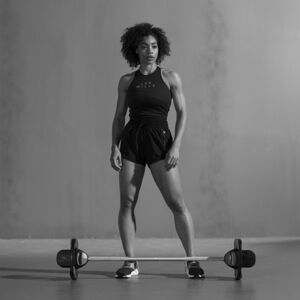TRAINING AND PERIODS: ARE YOU TUNED IN TO YOUR CYCLE?
Do you struggle through your training at different times of the month? If so, cut yourself some slack and tune in to each phase. Periodizing your training based on your menstrual cycle can be the smartest way to get the best from your body. Find out how.
The female body is amazing. Every month, a natural rise and fall of different hormones are cleverly orchestrated to prime the womb for pregnancy. It’s remarkable, wonderful, and let’s be honest, usually highly inconvenient too. Cramps, mood swings and the hassle of dealing with round-the-clock bleeding can make daily life hard … and exercising even harder.

The hormonal shifts women navigate each month can present a real challenge when it comes to maintaining consistent training habits. Research shows that about 75 percent of athletes experience negative side effects during their cycle – everything from cramps and back pain to headaches and bloating. Another study has shown fluctuations in strength, metabolism, inflammation, body temperature and injury risks as a result of hormonal changes throughout the cycle.
While the specific impact is different for everyone, regardless of whether you’re an athlete or a more casual exerciser, training throughout your cycle isn’t always easy. The more you understand the phases of your cycle, the more easily you can adapt your training to suit your body and your mind.
What are the phases of your cycle?
Your menstrual cycle starts on the first day of your period and ends when your next period begins. Usually, this is 28 days, but it can vary. Within your cycle, there are three phases: the follicular phase, ovulation and the luteal phase.
The follicular phase
The is the time between the first day of your period and ovulation.
Ovulation
This is halfway through your cycle when an egg is released from the ovary.
The luteal phase
This is the time between ovulation and before the start of menstruation, where your body prepares for a possible pregnancy.
Each phase is fueled by hormones – four in particular. In the early stages of your cycle, it is a hormone known as the follicle-stimulating hormone (FHS) that tells your ovaries to prepare and produce the egg-containing follicles. These follicles then produce the second hormone, estrogen, which rebuilds the lining of the uterus. Once the follicles are big enough and produce enough estrogen, the third hormone – luteinizing hormone (LH) – is produced. This releases the egg which causes ovulation. In this final phase, the follicle that contained the egg begins to produce the fourth hormone, progesterone. It is progesterone that helps prepare your uterus for a possible pregnancy.
How to train across the phases of your cycle
Early follicular phase
At the beginning of your cycle, while you are menstruating, your menstrual hormones are low. You may be dealing with symptoms like inflammation, pain and a good dose of lethargy. This is when you might want to be kind to yourself and train in a way that really nurtures your body and mind. A focus on recovery is often a good idea, as you want to avoid stresses which may trigger autoimmune responses. Nutritionally, make sure you get sufficient iron (as iron is lost when we lose blood) and choose meals with anti-inflammatory foods and antioxidants, such as salmon and green leafy or cruciferous vegetables. Slow-burning carbs like oats, legumes and pulses, and quality proteins can help here too.
Mid follicular phase
As the follicular phase progresses, estrogen starts to rise. This is when your energy levels may start to pick up and some find a higher pain tolerance. Some women find this can be the perfect time to train harder and push through high-intensity workouts and strength training. For some, strength training doesn’t only feel better in this phase, it might be even more effective because of the increased estrogen levels.
Les Mills presenter Kaylah Blayr usually feels real strong in the second week of her cycle and uses it to her advantage. “I plan to train heavy with my weights and I add in more to my workout sessions because I have the energy and it feels right. Sometimes, if I am feeling great later in the day, I will add a LES MILLS GRIT or LES MILLS SPRINT workout as my second workout of the day.”
Late follicular phase to ovulation
As estrogen levels peak at the end of the follicular phase, so too can your training performance. In this phase, right before ovulation, you may feel perfectly primed to smash your goals and break new training records. Interestingly, many find this time is also when appetite can decrease.
After her period, Les Mills presenter Khiran Huston says her mood and energy hits an all-time high. “Early morning workouts are not difficult and I feel motivated to train more – running a little longer, extending out my training in the gym.” For Khiran, this second week of her cycle is when her cardio training is at its best.
Luteal phase
After ovulation, your menstrual cycle hormones fluctuate fast. Energy levels and power can drop and you may be feeling heavier because of fluid retention. All of a sudden, your body is no longer primed for high-intensity training like it was in the follicular phase. Some women find that this is the perfect time to embrace longer, more steady-state training. You might like to focus on improving technique and movement efficiency, not pushing for a personal best. Parasympathetic activation can also be very advantageous during this phase – so enjoy activities like yoga, meditation and breathwork.
Kaylah says it’s during weeks three and four of her cycle that she usually feels very bloated, tired and lacking motivation. “This is when I lift lighter weights and add in workouts like RPM, THE TRIP or LES MILLS STRETCH, or even just walking. I choose my workouts depending on how I’m feeling.”
Khiran’s experience is similar. “This is when the early morning classes are not a vibe – in fact, they’re a struggle as I crave more sleep. I also know this is when I need to be careful with my weight lifting as I am more prone to injury or muscle soreness.”
“During this second half of my cycle, I ramp up my yoga sessions from two to four times a week,” says Khiran. “And I add in more yin yoga, which is slower pace where you hold the stretch for longer. My body absolutely loves it!”
It’s important to be aware that the shape of your cycle is unique and it can change at different points of your life. The hormonal shifts you experience your younger years can vary later in life and there can be significant changes when you reach menopause. Menopause is when periods stop and your hormones can go a little crazy, which drives a whole raft of different symptoms. These include hot flushes, insomnia and irritability. Staying active and doing exercise that you enjoy, including strength training, is key.
IN A NUTSHELL:
For many women, the first two weeks of your cycle can be a good time to push, hustle, grind and break records. During the last two weeks, you might want to scale that back and do the type of training that nurtures your body.
However, everyone is different. The number one thing you can do is pay attention to your cycle and learn more about how your body functions. There are a number of apps – such as Moody Month and FITR Women – that make tracking your cycle easy. With this awareness you can and greatly improve your athletic performance, your energy-levels, and your happiness.


